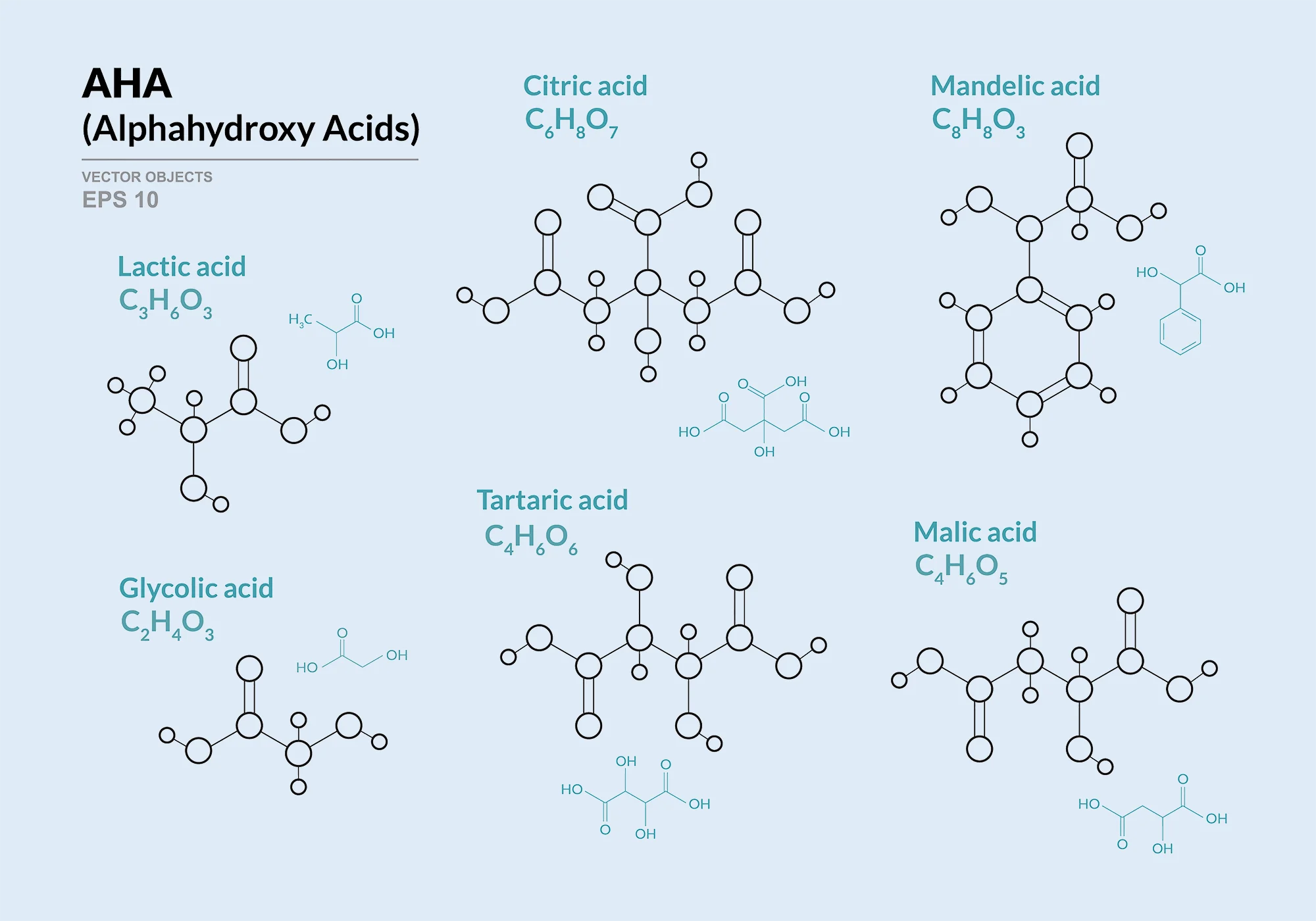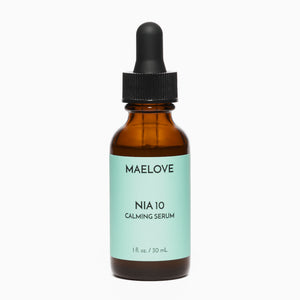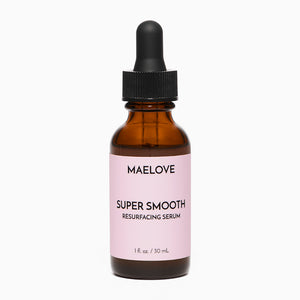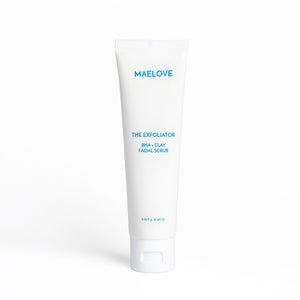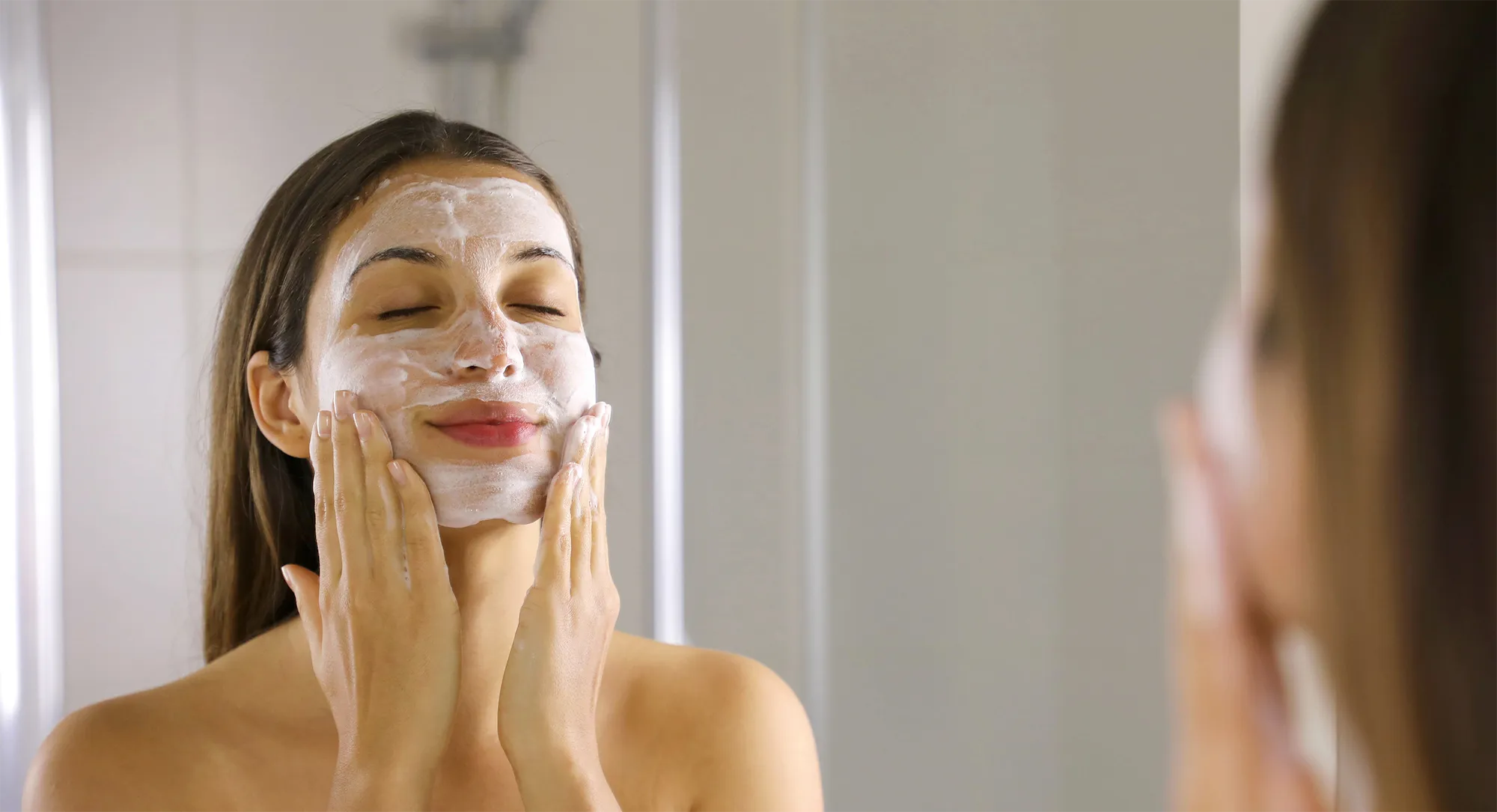This writeup was lead-authored by our senior technical adviser, Sunbin Song, PhD. Sunbin graduated from MIT with a degree in Biology before receiving a doctorate in neuroscience from Georgetown and becoming a research scientist at the NIH. When Sunbin isn't busy researching the brain, she loves to explore how we can best nurture our body, mind and spirit to live more joyful lives. Sunbin on Google Scholar / on ResearchGate
Today we’re covering hydroxy acids, such as alpha hydroxy acids (AHAs) and salicylic acid (popularly known as BHA), which are proven and powerful skincare ingredients that are a crucial part of an effective skincare routine.
Why should you be using hydroxy acids?
Fun fact: Cleopatra bathed in sour milk to achieve softer and smoother skin. That’s because sour milk contains lactic acid, a naturally occurring alpha hydroxy acid.
As Cleopatra can testify, hydroxy acids have been around since ancient times. They're naturally occurring in fruits, nuts, and milk, and are widely used in topical products today - hence, the safety information on them is also well researched and understood.
Hydroxy acids are generally well tolerated by most people, and clinical studies demonstrate their effectiveness empirically. The benefits of using hydroxy acids are wide ranging – from wrinkles, to pigmentation, to acne, and even moisture retention.
These are just a few reasons why everyone can benefit from using a form of hydroxy acid in their skincare routine – even those with sensitive skin!
Benefit 1 – Exfoliating with hydroxy acids will remove dead skin cells for a smoother and more even complexion.
Complete skin (epidermal) renewal occurs roughly every 28 days in young adults, while the same process takes 40 to 60 days for those with more mature skin types (Rodan et al. 2016).
In other words, every month or so young adults will resurface an entirely new set of skin cells, while this transformation will only take place every two months or so for more mature adults.
Like many biological processes, skin renewal and natural exfoliation weakens as we age, which means dead skin cells aren’t able to shed off as easily as they used to. This accumulated layer of dead skin makes the skin look rough, pores look enlarged, and complexion look dull (Rodan et al. 2016).
An important role hydroxy acids play are as chemical exfoliants - they loosen the bond between skin cells, facilitating the removal of dead skin cells.
Chemically exfoliating these skin cells will complement the natural process of exfoliation that occurs more regularly in younger skin types, revealing smoother, brighter, and younger looking skin (Kornhauser et al. 2010).
Regular removal of dead cells at the skin surface can also encourage a quicker renewal of the deeper underlying skin cells, which again mimics the renewal process in younger skin.
You can think of hydroxy acids like prune juice for the skin - It helps the new skin renewal cycle work more efficiently by purging the old skin cells.
With potent hydroxy acid products (such as 10% of actives in serums and creams) you can feel the effect of exfoliation as quickly as after the very first use.
The chemical peels you can get at your dermatologist office or medical spa use the same hydroxy acids as in your daily skincare products - but in much higher concentrations. Refer to Appendix A for more details on chemical peel and how it differs from exfoliation.
Benefit 2 – Hydroxy acids help support collagen production and moisture retention, which results in firmer, smoother skin.
Though the mechanisms are not fully understood, it seems that alpha hydroxy acids such as glycolic, lactic, and citric acid can improve skin by activating receptors (signaling pathways) that boost natural hyaluronic acid content and collagen production.
More collagen and hyaluronic acid means plump and youthful skin!
[Technically speaking: Hydroxy acids are able to activate signaling cascades, which increases collagen synthesis and hyaluronic acid content in the deeper layers of the skin. Glycolic acid in particular has been shown to activate underlying cellular processes that accelerate collagen synthesis by fibroblasts, and modulate matrix degradation through keratinocyte released cytokines (Okano et al 2003). This collagen building ability was found to increase with growing concentrations of glycolic acid, while also avoiding triggering inflammation when kept at a pH level of 4 (Narda et al. 2020).
In studies on sun-damaged skin, glycolic acid was found to increase hyaluronic acid content in the epidermis and dermis, as well as increasing collagen synthesis and epidermal thickness (Bernstein et al. 2001). This benefit is not just limited to glycolic acid, as citric acid has also been shown to lead to similar benefits to sun-damaged skin (Bernstein et al. 1997).
Double-blind, placebo controlled studies with lactic acid also show improved photo-damaged skin appearance in a similar manner as glycolic acid (Stiller et al 1996).]
Benefit 3 – Hydroxy acids can help fade hyperpigmentation and even out skin tone
Exfoliating with hydroxy acids (glycolic acid and lactic acid in particular) has been proven to improve hyperpigmentation.
Increased cell turnover via exfoliation is believed to help renew hyperpigmented skin and rapidly disperse existing pigment (Kornhauser et al. 2012), which helps to fade the appearance of hyperpigmentation.
Beyond exfoliation, there may be a secondary mechanism by which glycolic and lactic acids can help with hyperpigmentation- there is evidence that these acids inhibit tyrosinase activity (Kornhauser et al. 2012). The enzyme tyrosinase plays an important role in the synthesis of melanin, a substance that gives our skin its color. Therefore inhibiting tyrosinase leads to reduced melanin production, and regulating melanin production can in turn alleviate hyperpigmentation.
In some cases, the hyperpigmentation remains in the deeper layers of the skin where surface exfoliation will not suffice. In these cases, chemical peels are used to peel down to the deeper layers for a quick fix. However, skincare ingredients that act on tyrosinase in the melanocyte (including hydroxy acids) and dispersion of melanin from the melanocyte (such as niacinamide) can also slowly fade the hyperpigmentation from the source.
Benefit 4 – Hydroxy acids remove unwanted debris within pores to help clear up acne
For those prone to acne, you will want to look for salicylic acid (popularly known as BHA). Salicylic acid is tried and true and has been used for over a century for its acne fighting abilities. As salicylic acid is fat-soluble, it can penetrate and unclog congested pores which are full of sebum (an oily substance secreted by sebaceous glands in your skin)

A water-soluble hydroxy acid, such as glycolic, won’t penetrate as effectively into these fat-rich areas. Therefore, you want to reach for a fat-soluble hydroxy acid such as salicylic if you have stubborn pores to unclog.
Salicylic acid is also powerful in fighting acne due to its antibacterial properties (it works by downregulating virulence factors for bacterial replication (Kornhauser et al. 2010)).
While salicylic acid is often considered as the star hydroxy acid for treating acne, other hydroxy acids, such as glycolic, have been shown to be effective in treating acne as well (Babilas et al. 2012). Because of this, many acne treatment formulations combine salicylic acid in combination with alpha hydroxy acid (AHA) for better product performance (Kornhauser et al. 2010).
Benefit 5 – Hydroxy acids support the skin's acid mantle by maintaining the pH level of the skin
The skin’s surface and stratum corneum have a naturally acidic pH between 4 and 6, and this acidity (also referred to as “acid mantle”) is essential for maintaining healthy skin (Lukic et al. 2021).
The acid mantle (along with the role of pH in skincare products) is a complicated topic that deserves its own deep guide in the future (for now, you can refer to Appendix B for some technical discussions on the acid mantle). For now, keep in mind these two key benefits of healthy acid mantle:
(1) Healthier acid mantle can dampen harmful bacterial activities - combats acne
(2) Healthier acid mantle boosts the skin’s ability to hold onto water - combats dryness
The importance of researching pH levels in skincare products is to ensure the products won’t disturb the skin’s acid mantle. To summarize, here’s what you need to know about pH levels in skincare:
1. Avoid using any skincare product with an alkaline pH (a pH of 8 or greater) including in soap or body wash.
2. Since even water (which has a neutral pH of 7, though tap water pH varies) can potentially disturb your skin’s pH level, we recommend using an acidic face wash to balance the skin’s pH during washing. Alternatively, you can also use an acidic skincare product afterwards.
In the past, toners played the primary role of supporting the skin’s acidity. But if you use other skincare products that have acidity (e.g. Vitamin C serums or hydroxy acid products), then toners are unnecessary in our view.
Convinced yet? Here's what you should look for in a hydroxy acid skincare product
Glycolic acid, lactic acid, and salicylic acid are the top hydroxy acids with the most research to support their effectiveness. Therefore, we recommend that you look for these 3 ingredients in particular.
For those with oily or acne prone skin, salicylic acid is recommended (due to its fat-solubility) as it works to unclog pores full of oily sebum and dead skin cells, while also having its own unique bacteria fighting properties.
For those with sensitive skin, you may want to begin with gentle, rinse-off hydroxy acid products first (such as hydroxy acid infused cleansers) rather than high potency, leave-on products such as serums and creams.
How often and when should you apply?
Hydroxy acids can be found in cleansers, masks, serums and creams and are generally safe to use as often as you would like.
When hydroxy acids are used in a mask or cleanser, they sit on your skin for a shorter amount of time than when found in leave-on products like serums and creams. In general, the longer the amount of time hydroxy acids sit on your skin, the deeper the penetrative exfoliation.
Hydroxy acid products have been tested in combination with Vitamins C and E, as well as niacinamide, and this combination has been found to be effective and well tolerated (Tran et al. 2014).
Hydroxy acids have also been tested with retinoids - and while retinoids can be irritating - the combination is very effective (Bertin et al. 2008). In other words, you can feel confident combining hydroxy acids, niacinamide, retinoids and Vitamin C products into your routine together. Apply your serums before creams. And if you have history of skin sensitvity, introduce just one new product at a time as to not overwhelm your skin.
As mentioned earlier, our skin is naturally acidic which is why acidic skincare products are generally well tolerated. We recommend avoiding skincare products with an alkaline pH of 8 or higher, or if you do use an alkaline product, make sure to follow it up immediately with an acidic product to restore the acidic pH.

Things to keep in mind when using hydroxy acids
Be mindful of sun exposure
Unsurprisingly, use of hydroxy acids comes with increased sun sensitivity. Because when you exfoliate away the dead cells on the skin’s surface, UV rays are able to penetrate deeper into your skin.
An interesting exception to the increased sunburn risk is salicylic acid. Studies suggest salicylic acid might actually be sun-protective, as it absorbs UV (thereby acting like sunscreen). In fact, derivatives of salicylic acid are considered for use as UV protectants (Kornhauser et al. 2012).
Regardless, we recommend applying SPF every morning as a part of your morning routine.
In addition to sunscreen, antioxidants such as Vitamin C and E can offer additional protection against UV damage (see our Vitamin C Deep Guide).
Watch out for symptoms of over-exfoliation, which include redness, inflammation and dry skin.
When exfoliating properly, you should not be experiencing dry skin. Alternatively, if you feel that your skin has become dry, it’s likely you are over-exfoliating.
Those with sensitive skin might notice burning, stinging, itching, scaling, and other negative reactions to a hydroxy acid.
Skin sensitivity is correlated to poor (“leaky”) skin barrier. Poor skin barrier function allows an excess of external elements (skincare ingredients, pollution, bacteria, etc.) to be absorbed, and ironically, too much absorption of hydroxy acids can lead to irritation (Ding et al 2019).
Those with sensitive skin can try using a gentle, non-irritating ingredient that repairs the skin barrier (such as niacinamide) to ease dryness and skin sensitivity first. You can then add more skincare products containing ingredients such as Vitamin C, retinoids or hydroxy acids.
Since a healthy acid mantle is necessary for a good skin barrier, try seeing if you can tolerate a hydroxy acid face wash. Since cleansers don’t stay on the skin’s surface for an extended period like a cream or serum would, hydroxy acid cleansers will not be absorbed deep into the skin and shouldn't cause irritation.
Niacinamide serums are typically slightly acidic, just inline with skin’s natural acidity, and thus could be a good way to introduce your skin to acidic products.

Is salicylic acid safe for pregnancy?
Long story short, yes it is. However, we recommend skipping any chemical peels until after your pregnancy, and if you’re hesitant to use salicylic acid you can get most of the same benefits from glycolic acid.
The general concern is that since salicylic acid is fat soluble, it has more potential to penetrate deeper into skin and enter the blood stream.
Thus, while salicylic acid skincare products are deemed safe, we recommend avoiding chemical peels (performed at medical spas or doctor’s offices) because chemical peels involve much higher concentration of acids and penetrate far deeper into the layers of the skin.
The concerns over salicylic acid are largely based on aspirin studies (fun fact - aspirin is a form of salicylic acid). It seems that in high doses, aspirin can be teratogenic in animals. As such, the general recommendation is to avoid aspirin during pregnancy.
On the other hand, topically applied skincare products containing salicylic acid are very unlikely to cause any issue due to the (1) low concentration of salicylic acid (2% or lower in most cases) and (2) the limited ability of any topically applied product to reach the blood stream.
[Technically speaking: Researchers found that, specifically, up to 75mg/kg/day of ingested salicylic acid (in form of aspirin) is ok and beyond that you can have problems.
The Cosmetic Ingredient Review (CIR) calculated you would need 177 times the concentration as you would normally find in skincare products (2% salicylic acid in face creams or 0.2% salicylic acid in body lotion) to reach that 75mg/kg/day dosage. So that is why the CIR and FDA declare it relatively safe to use salicylic acid skincare products while pregnant. ]
Wrapping it all up - Hydroxy acids are great!
If you’re looking to treat pigmentation, acne, or aging skin, hydroxy acids should definitely play an important role in your skincare routine.
Look for glycolic acid, lactic acid or salicylic acid, as these are three of the most common, effective, and extensively researched hydroxy acids.
Those with sensitive and/or chronically dry skin may be suffering from a damaged skin barrier, and can benefit from adding acidic products into their routine. We recommend starting out slow by using rinse-off products such as cleansers infused with hydroxy acids, and gentle, non-irritating ingredients such as niacinamide to help restore a damaged skin barrier. Once the skin barrier is restored, more potent products that contain higher concentrations of hydroxy acids, Vitamin C and retinoids can be used as well.
Why we wrote this
With such a vast amount of information available about skin care on the internet, it can be overwhelming trying to figure out what to believe.
Our aim was to summarize the main, validated, scientific findings on beneficial skincare ingredients in an in-depth but easy to digest manner. That way, you'll be informed about how skin care ingredients and products really work. You’ll also be empowered to filter information, enabling you to have more productive conversations with your physician.
This writeup is not a sales pitch, but rather it’s meant to provide you with helpful information that can be verified with widely available public information. That’s why there are no mentions of any proprietary research, or specific product recommendations.
Appendix A - Exfoliation vs Peel
To summarize: exfoliation = shallow, peels = deep

The hydroxy acids in your skincare products are actually the same hydroxy acids found in medical chemical peels (such as the chemical peels you get at your dermatologist office or medical spa) (Arif 2015, Chilicka et al. 2020, Garg et al. 2009, Sharad 2018).
However, chemical peels use much higher concentrations of hydroxy acids such as glycolic and lactic acid. 10% to 40% hydroxy acid solutions can be used by trained professionals in salons, and over 40% hydroxy acid solutions should only be used by medical professionals.
These types of peels are intended to go beyond just exfoliating the skin’s surface layer. They penetrate the deeper, living layers of the epidermis, and some strengths will go as deep as into the dermis.
The goal of these strong chemical peels is to remove deep imperfections in skin such as acne scars, deep wrinkles or hyperpigmentation (Gozali et al. 2015). But keep in mind, chemical peeling can be risky, so make sure to put yourself in the hands of a professional and don’t try this at home.
Appendix B - More about acid mantle
The creation of the acid mantle:
The acid mantle is formed in part by filaggrin proteolysis and release of free amino acids and their derivatives including urocanic acid and pyrrolidone carboxylic acid into the cytosol of corneocytes of the stratum corneum, a process impaired in ichthyosis (Cau et al. 2017), a condition characterized by dry, scaly skin. Other pathways contribute as well including free fatty acid processing, a sodium/proton exchanger, and cholesterol sulfate ionization and hydrolysis (Lukic et al. 2021).
Sebum can release free fatty acids to the surface of the skin, while sweat can release urea, lactic acid, sodium and potassium to the skin surface. Hence the acid mantle is formed by the combination of the acidic nature of the cells themselves that constitute the stratum corneum, and the acidic components on the surface of the skin released by sebum and sweat.
Many times, components of the acid mantle perform double duty, not only acidifying the skin but also acting as humectants. Urocanic acid and pyrrolidone carboxylic acid from fillagrin breakdown are also highly hygroscopic which means they can hold water. Lactic acid is also a humectant.
Healthier acid mantle can dampen harmful bacterial activities:
A reason why the skin’s acidity is crucial is because the skin provides a protective barrier function for our entire body. While the outer skin is acidic, the blood is alkaline at pH 7.4, while the inside living body tissue is at a neutral pH of 7.0. It is believed this has evolved so that bacteria living on the surface of the skin, when they enter into the bloodstream, aren’t used to surviving the alkaline environment so they die. By humans adapting in this way with acid skin and alkaline interior, you make sure you don’t have teams of bacteria living on your skin that could harm you inside your body. Same concept with viruses.
For example, a higher skin pH coupled with sebum overproduction encourages the growth of P. Acnes (also known as C. Acnes), a bacteria implicated in the development of acne. And another way hydroxy acids might fight acne is by lowering the pH of the skin so that it is a less conducive environment for P. Acnes. This was found by Valle-Gonzalez et al. (2020) who used glycolic acid at various pH levels and found it killed P. Acnes. The bactericide activity was optimal below a pH of 4.0 but was inactive above a pH of 5.0 suggesting a pH of 4 or below is necessary for this activity.
Healthier acid mantle boosts the skin’s ability to hold onto water:
When the acid mantle is perturbed by ichthyosis or by alkaline soaps, or even by soaking in water which has a neutral pH, it leads to drier skin due to the resultant impaired skin barrier function and increasing trans-epidermal water loss. This is because enzymes important for synthesis of skin barrier components operate better at a lower pH while enzymes that break down skin barrier components are activated at a neutral to high pH.
Specifically, ceramide generating hydrolytic enzymes (B-glucocerebrosidase and acidic sphingomyelinase) with low pH optima (pH<5) build the lipid-rich lamellar membranes that make the stratum corneum largely water-proof, while serine proteases are induced by an increased pH and these degrade enzymes that form ceramides, free fatty acids, and corneodesmosome constituent proteins (Hachem et al. 2010). Excessive serine protease activity is a characteristic of atopic dermatitis for example, which is associated with dry skin.
Hydroxy acids are also known to be highly moisturizing and this action may be through supporting of the acid mantle which then increases skin barrier function and the ability to keep in water. Improved barrier function and increased skin ceramides have been found in human studies using lactic acid (Rawlings et al. 1996).
A mechanism for the improvement in the skin barrier function was investigated in a study by Hachem et al. 2010 who acidified the stratum corneum by PHAs lactobionic acid or gluconolactone. The acid treatments led to faster recovery of skin barrier function and reduced trans-epidermal water loss after tape stripping compared to vehicle treatment. They found that this was in part due to increases in lipid-rich lamellar components and increased in corneodesmosome density driven by two mechanisms: the activation of ceramide generating enzymes optimized for low pH (pH<5), and by decreasing serine protease activity which is optimized by a neutral to high pH which in turn would prevent decreases in ceramides, free fatty acids and corneodesmosome constituent proteins.. Better skin barrier = better ability to hold in water and lower TEWL (transepidermal water loss).
The waterproof skin barrier is formed by the stratum corneum using a “brick and mortar” structure with the bricks formed by layers of flattened protein-rich corneocytes connected to each other by corneodesmosomes, and the lipid-rich mortar channels made of fatty lipids, ceramides, and cholesterol. Lipid soluble or nonpolar molecules passes through those channels. The more lipid content in the stratum corneum, the better its water-proofing functioning. When functioning correctly, water should not easily come in or out. Some people for whatever reason don’t have a good barrier and is “leaky” and water evaporates out easily, while molecules leech in easily. They have impaired skin barrier function of stratum corneum.
Appendix C - What exactly are hydroxy acids?
Now that you know what hydroxy acids are used for, you may ask yourself, but what are they?
In technical terms, hydroxy acids are acids that have a hydroxyl group in the molecule in addition to the acid group itself. An alpha hydroxy acid (AHA) has a hydroxyl group in the alpha position, and a beta hydroxy acid (BHA) has a hydroxyl group in the beta position Does that clarify the picture?
Of course not. In fact, even experts are confused. For example, salicylic acid is often called a beta hydroxy acid when really, it is in its own class of hydroxy acid as a monohydroxy benzoic acid (Kornhauser et al. 2012). However, the FDA classifies salicylic acid as a BHA albeit with an asterisk that says, “From a chemist’s perspective, salicylic acid is not a true BHA. However, cosmetic companies often refer to it as a BHA and consequently, many consumers think of it as one.”
Basically, somehow salicylic acid got labeled as being a beta hydroxy acid, and it stuck over time. And we at Maelove are also guilty of referring salicylic acid as BHA.
In our opinion, the technical classifications do not necessarily matter although it is useful to understand what each of the hydroxy acids bring to the table. Some people like to understand them as acids that are naturally occurring in fruits, nuts, and milk and so they are often called fruit acids.
The most commonly used are glycolic acid (found in sugarcane), lactic acid (found in sour milk and fermented plants), and salicylic acid (found in many flowering shrubs) (Kornhauser et al. 2010).
References
Anderson FA. “Final report on the safety assessment of glycolic acid, ammonium, calcium, potassium, and sodium glycolates, methyl, ethyl, propyl, and butyl glycolates, and lactic acid, ammonium, calcium, potassium, sodium, and tea-lactates, methyl, ethyl, isopropyl, and butyl lactates, and lauryl, myristyl, and cetal lactates.” (1998) International Journal of Toxicology, 17(Suppl 1): 1-241.
Arif T. “Salicylic acid as a peeling agent: a comprehensive review.” (2015) Clinical, Cosmetic and Investigational Dermatology. 8:455-461.
Babilas P, Knie U, Ables C. “Cosmetic and dermatologic use of alpha hydroxy acids.” (2012). JDDG 10: 488-491.
Bernstein EF, Underhill CB, Lakkakorpi J, Ditre CM, Uitto J, Yu RJ, Scott EV (1997). “Citric acid increases viable epidermal thickness and glycosaminoglycan content of sun-damaged skin.” Dermatol surg. 23(8): 689-694.
Bernstein EF, Lee J, Brown DB, Yu R, van SE (2001). “Glycolic acid treatment increases type I collagen mRNA and hyaluronic acid content of human skin.” Dermatol Surg. 27(5):429–433.
Cardoso T, Marques C, Dagostin JLA, Masson ML (2019). “Lactobionic acid as a potential food ingredient: Recent Studies and Applications.” J Food Sci 84(7): 1672-1681.
Cau L, Pendaries V, Lhuillier E, Thompson PR, Serre G, Takahara H, Mechin MC, Simon M. “Lowering relative humidity level increases epidermal protein deimination and drives human fillaggrin breakdown.” (2017) J Dermatol Sci. 86(2): 106-113.
Chilicka K, Rogowska AM, Szygula R, Taradaj J. (2020). “Examining Quality of Life after Treatment with Azelaic and Pyruvic Acid Peels in Women with Acne Vulgaris.” Clinical, Cosmetic and Investigational Dermatology. 13: 469-477.
Ding DM, Tu Y, Man MQ, Wu WJ, Lu FY, Li X, Li Y, Yang JT, Jim YM, Yang CY, He L. (2019). International Journal of Cosmetic Science 41:398-404.
Edison BL, Green BA, Wildnauer RH, Sigler ML. “A polyhydroxy acid skin care regimen provides antiaging effects comparable to an alpha-hydroxy acid regimen.” (2004). Cutis 73 (2 Suppl): 14-8.
Garg VK, Sinha S, Sarkar R (2008). “Glycolic Acid Peels Versus Salicylic-Mandelic Acid Peels in Active Acne Vulgaris and Post-Acne Scarring and Hyperpigmentation: A Comparative Study.” Dermatol Surg 35:59-65.
Gozali MV, Zhou B, Luo D (2015). “Effective Treatments of Atrophic Acne Scars” Journal of Clinical and Aesthetic Dermatology. 8(5): 33-40.
Hachem JP, Roelandt T, Schurer N, Pu X, Fluhr J, Giddelo C, Man MQ, Crumrine D, Roseeuw D, Feinhold KR, Mauro T, Elias PM (2010). “Acute Acidification of Stratum Corneum Membrane Domains Using Polyhydroxyl Avids Improves Lipid Processing and Inhibits Degradation of Corneodesmosomes.” Journal of Investigative Dermatology. 130: 500-510.
Kornhauser A, Coelho SG, Hearing VJ (2010). “Application of hydroxy acids: classification, mechanisms, and photoactivity.” Clinical, Cosmetic and Investigational Dermatology. 3: 135-142.
Kornhauser A, Coelho SG, Hearing VJ. (2012) “Effects of Cosmetic Formulations Containing Hydroxyacids on Sun-Exposed Skin: Current Applications and Future Developments.” Dermatology Research and Practice.
Lukic M, Pantelic I, Savic SD (2021). “Towards Optimal pH of the Skin and Topical Formulations: From the Current State of the Art to Tailored Products.” Cosmetics 8, 69. //doi.org/10.3390/cosmetics8030069
Narda M, Trullas C, Brown A, Piquero-Casals J, Granger C, Fabbrocini G. (2021) “Glycolic acid adjusted to pH 4 stimulates collagen production and epidermal renewal without affecting levels of proinflammatory TNF-alpha in human skin explants.” Journal of Cosmetic Dermatology. 20:513-521.
Okano Y, Abe Y, Masaki H, Santhanam U, Ichihashi M, Funasaka Y. Biological effects of glycolic acid on dermal matrix metabolism mediated by dermal fibroblasts and epidermal keratinocytes. Exp Dermatol. 2003;12 Suppl 2:57–63.
Rawlings AV, Davies A, Carlomusto M, Pillai S, Zhang K, Kosturko R et al. (1996) Effect of lactic acid isomers on keratinocyte ceramide synthesis, stratum corneum lipid levels and stratum corneum barrier function. Arch Dermatol Res 288:383–90
Rodan K, Fields K, Majewski G, Falla T. “Skincare Bootcamp: The evolving role of skincare.” (2016). Plast Reconstr Surg Glob Open: e1152. doi: 10.1097/GOX.0000000000001152.
Sharad J (2013). “Glycolic acid peel therapy – a current review.” Clnical, Cosmetic and Investigational Dermatology 6: 281-288.
Soleymani T, Lanoue J, Rahman Z (2018). “A practical approach to chemical peels: A review of fundamentals and step-by-step algorithmic protocol for treatment.” J Clin Aesthet Dermatol 11(8): 21-28.
Stiller MJ, Bartolone J, Stern R, Smith S, Kollias N, Gillies R, et al. Topical 8% glycolic acid and 8% L-lactic acid creams for the treatment of photodamaged skin. A double-blind vehicle-controlled clinical trial. Arch Dermatol 1996;132:631-636.
Tran D, Townley JP, Barnes TM, Greive K. (2014). “An antiaging skin care system containing alpha hydroxy acids and vitamins improves the biochemical parameters of facial skin.” Clinical, Cosmetic and Investigational Dermatology. 8:9-17.
Valle-Gonzalez ER, Hackman JA, Yoon BK, Mokrzecka N, Cho NJ (2020). “pH-Dependent Antibacterial Activity of Glycolic Acid: Implications for Anti-Acne Formulations.” Scientific Reports 10:7491.
